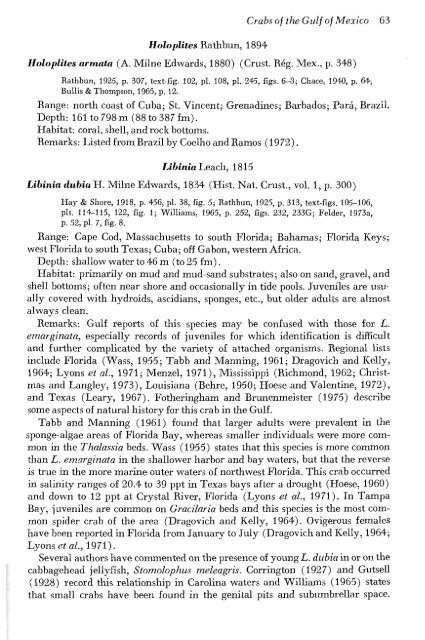Create successful ePaper yourself
Turn your PDF publications into a flip-book with our unique Google optimized e-Paper software.
Holoplites Rathbun, 1894<br />
Crabs of the Gulf of Mexico 63<br />
Holoplites armala (A. Milne Edwards, 1880) (Crust. Reg. Mex., p. 348)<br />
Rathbun, 1925, p. 307, text-fig. 102, pi. 108, pi. 245, figs. 6-8; Chace, 1940, p. 64;<br />
BuIIis & Thompson, 1965, p. 12.<br />
Range: north coast of Cuba; St. Vincent; Grenadines; Barbados; Para, Brazil.<br />
Depth: 161 to 798 m (88 to 387 fm).<br />
Habitat: coral, shell, and rock bottoms.<br />
Remarks: Listed from Brazil by Coelho and Ramos (1972).<br />
Lifoinja Leach, 1815<br />
Libinia dubia H. Milne Edwards, 1834 (Hist. Nat. Crust., vol. 1, p. 300)<br />
Hay & Shore, 1918, p. 456, pi. 38, fig. 5; Rathbun, 1925, p. 313, text-figs. 105-106,<br />
pis. 114-115, 122, fig. 1; Williams, 1965, p. 252, figs. 232, 233G; Felder, 1973a,<br />
p. 52, pi. 7, fig. 8.<br />
Range: Cape Cod, Massachusetts to south Florida; Bahamas; Florida Keys;<br />
west Florida to south Texas; Cuba; off Gabon, western Africa.<br />
Depth: shallow water to 46 m (to 25 fm).<br />
Habitat: primarily on mud and mud-sand substrates; also on sand, gravel, and<br />
shell bottoms; often near shore and occasionally in tide pools. Juveniles are usually<br />
covered with hydroids, ascidians, sponges, etc., but older adults are almost<br />
always clean.<br />
Remarks: Gulf reports of this species may be confused with those for L.<br />
emarginata, especially records of juveniles for which identification is difficult<br />
and further complicated by the variety of attached organisms. Regional lists<br />
include Florida (Wass, 1955; Tabb and Manning, 1961; Dragovich and Kelly,<br />
1964; Lyons et al., 1971; Menzel, 1971), Mississippi (Richmond, 1962; Christmas<br />
and Langley, 1973), Louisiana (Behre, 1950; Hoese and Valentine, 1972),<br />
and Texas (Leary, 1967). Fotheringham and Brunenmeister (1975) describe<br />
some aspects of natural history for this crab in the Gulf.<br />
Tabb and Manning (1961) found that larger adults were prevalent in the<br />
sponge-algae areas of Florida Bay, whereas smaller individuals were more common<br />
in the Thalassia beds. Wass (1955) states that this species is more common<br />
than L. emarginata in the shallower harbor and bay waters, but that the reverse<br />
is true in the more marine outer waters of northwest Florida. This crab occurred<br />
in salinity ranges of 20.4 to 39 ppt in Texas bays after a drought (Hoese, 1960)<br />
and down to 12 ppt at Crystal River, Florida (Lyons et al., 1971). In Tampa<br />
Bay, juveniles are common on Gracilaria beds and this species is the most common<br />
spider crab of the area (Dragovich and Kelly, 1964). Ovigerous females<br />
have been reported in Florida from January to July (Dragovich and Kelly, 1964;<br />
Lyons e/a/., 1971).<br />
Several authors have commented on the presence of young L. dubia in or on the<br />
cabbagehead jellyfish, Stomolophus meleagris. Corrington (1927) and Gutsell<br />
(1928) record this relationship in Carolina waters and Williams (1965) states<br />
that small crabs have been found in the genital pits and subumbrellar space.

















